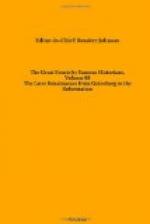The centre consisted of Gascon infantry, small, light, agile men, whose numbers seemed to multiply as the army advanced. But the grandest sight was the cavalry, comprising the flower of the French aristocracy, and displaying finely wrought weapons, mantles of gorgeous brocade, velvet banners embroidered with gold, chains of gold, and other precious ornaments. The cuirassiers had a terrible aspect, for their horses seemed like monsters with their cropped tails and ears. The archers were men of extraordinary height, armed with very long wooden bows; they came from Scotland and other northern countries, and, in the words of a contemporary historian, “seemed to be beast-like men” ("parevano uomini bestiali").
This well-ordered and disciplined army, composed of so many different nationalities, with such varied attire and strange weapons, was as new and amazing a sight to Florence as to almost all Italy, where no standing armies were as yet in existence, and mercenaries the only soldiery known. It is impossible to give the number of the forces accompanying the King to Florence, for his artillery were marching toward Rome by another route; he had left garrisons in many strongholds, and sent on another body of men by Romagna. Gaddi, who witnessed the entrance of the French, says that their numbers amounted to twelve thousand; Rinuccini, who was also present, estimated them at a lower figure; others at a higher. In any case the city and suburbs were crammed with them.
The procession marched over the Ponte Vecchio ("Old Bridge"), which was gay with festive decorations and sounds of music, wound across the Piazza amid a crowd of triumphal cars, statues, etc., and, passing the Canto dei Pazzi, made the tour of the Cathedral Square, and halted before the great door of the church. The people shouted the name of France with cries of applause, but the King only smiled inanely and stammered some inappropriate words in Italian. Entering the Duomo, he was met by the seigniory, who, to avoid the pressure of the armed host, had been obliged to come around by the back streets. After joining in prayers with their royal guest, they escorted him to the sumptuous palace of the Medici, and the soldiers dispersed to their quarters. That night and the next the whole city was a blaze of illuminations; the intervening day was devoted to feasting and amusements, and then the terms of the treaty began to be discussed.




